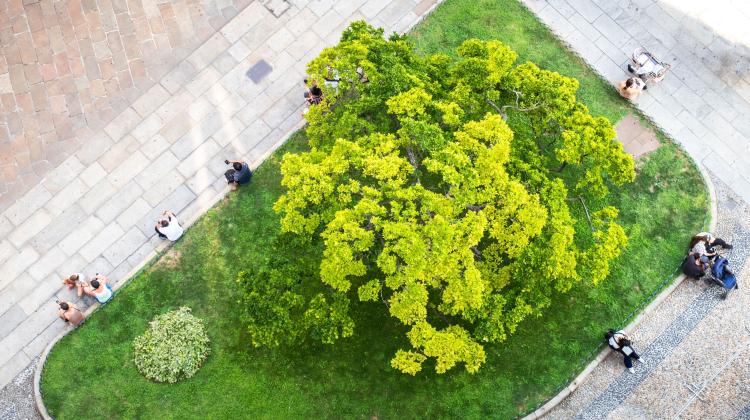Urban green space can mitigate the effects of climate change, say experts
 Credit: Adobe Stock
Credit: Adobe Stock
Scientists investigate how 'green' our cities are. The results of their research can help effectively use urban green spaces to mitigate the effects of climate change. Shaping green infrastructure is one of the five topics investigated by experts in the 'City with Climate' project.
Experts from a consortium of research and scientific institutions, which include: the Institute of Environmental Protection - National Research Institute (leader), the Forest Research Institute, the Institute for Ecology of Industrial Areas and the National Centre for Nuclear Research, strategically advise 15 Polish cities, winners of the competition 'City with Climate - analysis of activities undertaken by cities', organized by the Ministry of Climate and Environment.
'The experience and know-how of these institutions will help the cities participating in the project to look holistically at the problem of adaptation to climate change and reducing the pressure of cities on the environment,’ says Michał Marcinkowski from the Institute of Environmental Protection - National Research Institute.
Fifteen cities out of 20 winners of the competition have joined the project 'Strategic consulting under the City with Climate project - stage II'. These cities are: Bielsko-Biała, Czempiń, Hrubieszów, Jasień, Knurów, Krynica-Zdrój, Mrocza, Olsztyn, Rzeszów, Suwałki, Sztum, Świdnik, Tarnobrzeg, Ustka and Wyszków.
In urban areas - where deforestation, surface sealing, reduction of wetlands and regulation of rivers have taken place - there are changes in water conditions and lowering of air humidity. Rainwater has a limited ability to soak into the soil. Flooding occurs as a result of sudden and intense rainfall. Cities also face the problem of elevated temperatures, particularly troublesome in areas devoid of greenery and water facilities.
'In the City with Climate project, we focus on issues related to air quality, energy transformation, urban retention, zero-emission transport, as well as urban green spaces. In the case of the latter, we are working on defining their scope, structure and nature, so that in the next step planning and program activities can be undertaken in cities, shaping their green infrastructure,’ says Marcinkowski.
Experts from the Forest Research Institute analyse the surface of tree crowns, determine the health of greenery, and present changes in the above-mentioned resources over time and space. 'Remember that many cities in Poland are not really able to determine what greenery resources they have in their area. Traditional field inventory provides the most detailed information about the resources and condition of greenery, but it is both a time-consuming and costly process,’ Marcinkowski says.
Thanks to the development of remote data acquisition technology, a comprehensive or partial inventory of greenery in cities can be carried out using such data as aerial photos or satellite images.
'One of the basic products that can be generated based on these materials is a tree crown cover map,’ say researchers from the Department of Geomatics of the Forest Research Institute, specializing in the analysis and processing of airborne laser scanning data.
The continue: ‘This type of data allows us to look at trees as actual three-dimensional objects and, if the quality of the data allows, determine the exact canopy projection of each tree or group of trees. This gives a precise answer to the question of the state of urban vegetation.’
In the longer term, researchers can determine the trends of changes in urban greenery and where, for example, new plantings have been made. 'Data on tree canopy cover can be valuable information for decision-makers in terms of planning further development of the city, as well as looking back at the changes that have taken place in recent years,’ they say.
Urban green spaces are among the tools cities can use to adapt to climate change. 'Numerous studies show that the benefits of the presence of greenery in cities far outweigh the outlays that cities incur for its maintenance. These data may be used in the future to shape green infrastructure in cities with appropriate changes in the law at the national level,’ the experts say.
As part of the project, the team of the Institute for Ecology of Industrial Areas prepares an averaged map of the earth's surface temperature for a given city, and on this basis identifies the nature and extent of the surface urban heat island (UHISurf). The support includes calculating the average temperature for different land uses, soil sealing classes and major slope directions. In addition, the size of the population of the city's inhabitants located within the UHISurf range is estimated and areas with increased thermal risk identified. Scientists have proven that this phenomenon reduces the thermal comfort of residents, poses a threat to health and even life, especially for the elderly, the sick and children.
As part of the project, it is recommended to strengthen the so-called blue-green infrastructure (BGI), i.e. a network of areas covered with vegetation or water and solutions based on natural functions. 'It is an element that compensates for high temperatures in the city and increases the humidity of the environment,’ experts say.
It is estimated that trees in European cities can reduce the temperature in the city by up to 12 degrees Celsius compared to unforested areas. Measures that enhance BGI maintain an appropriate amount of biologically active areas and increase biodiversity. Another important effect of introducing BGI is the unsealing of the surface, which allows water to penetrate freely into the soil. 'Such solutions reduce the risk of flooding and, as a consequence, damage to infrastructure and property', the researchers say.
In addition to research and consultancy on urban greenery, experts working in the 'City with Climate' project provide strategic consulting to selected cities in such categories as: air quality, energy transformation, urban retention and zero-emission transport. The project is financed entirely by the National Fund for Environmental Protection and Water Management, so the participating cities do not incur costs related to the expert support. Its total budget is over PLN 6 million.
'This sum includes the cost of the provided expert support and the development (refining) of the Road map of the city's transformation towards climate neutrality and resilience (RMT) for each city,’ says says Michał Marcinkowski from the Institute of Environmental Protection - National Research Institute. In addition to RMT, a total of over 100 different products are created for the participating cities, including reports, analyses, maps, datasets, etc.
The current stage of the project started in April 2022 and will end with a summary conference in mid-September 2023. According to the project representatives, 'the research on green space in cities is in line with the activities of the European Commission and its European Biodiversity Strategy'. The European Commission recommends the preparation of Urban Greening Plans, and the Ministry of Climate and Environment is preparing legislation in this area - taking these plans into account as part of urban projects of adaptation to climate change. (PAP)
PAP - Science in Poland, Anna Mikołajczyk-Kłębek
amk/ bar/ kap/
tr. RL
Przed dodaniem komentarza prosimy o zapoznanie z Regulaminem forum serwisu Nauka w Polsce.



















